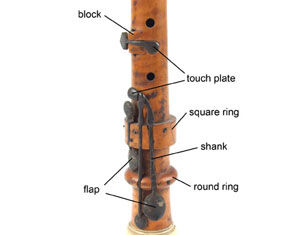Terminology and Glossary
 Barrel
Barrel
The section of an instrument located between the mouthpiece, head joint or crook and the main sections. A separate section in this location enables the player to adjust overall tuning.
The bottom or last section of a wind instrument, usually flared.
Crook
In double reed instruments, a section of bent or curved tubing, usually metal, that connects the reed to the main body of the instrument.
Flap
The part of the key which covers the sound hole. It is usually made air-tight by a pad of leather, cork or cloth attached to the underside of the flap or a plug. See illustration.
Joints
The individual sections of wind instruments, usually where the main keywork is located.
Plug
See key flap designs.
Shank
The part of the key that connects touch and flap. A hole drilled through the edge of the shank accommodates a metal wire or screw on which the key then pivots. See illustration.
Spring
Springs, usually metal, are used to return the key to its original position after being depressed by the player. Springs can be attached to the body of the instrument, or to the material of the keys.
Flat spring or Leaf spring: A hammered metal spring (usually brass or steel), attached by screw or rivet to the finger end of a key. It is also sometimes screwed into the key mount assembly, so that it exerts an upward pressure on the rear of the key.
Keys mounted in metal saddles were frequently sprung in this optional reverse manner in the early stages.
Needle spring: Used on some of the post and rod key designs - in which round, tapered springs, wedged into small post holes, controlled key return - for some or all of the keys that pivoted on a hinge rod assembly. They usually work in parallel to the axis of the key, and the narrow end of the spring is engaged by a small hook brazed to a key element.
Touch plate or Finger plate: The part of the key on which the finger or thumb presses to activate the key. See illustration.
Key mounts
There are numerous ways in which makers have mounted keys onto the body of an instrument. The following are the main ones found on instruments in the collection:
Ring: A raised ridge on the body formed during turning, with a square or round cross-section. Keys are usually secured to rings by metal pins. See illustration.
Block: A ring reduced to the minimum amount of wood needed to mount a key. Keys are usually secured to blocks by metal pins. See illustration.
Saddle: A metal u-shaped channel screwed through its flat bottom to the wood body surface. It may be of varying length, depending on its application. Some later saddles have extended foot-plates to provide screw-holes outside the key channel itself.
Pillars or post and axle mounts: The pillars are the most common means of mounting keys for the last 150 years. The pillars may be screwed into the wood, soldered onto the metal body or may be first attached to a metal strap or bed-plate, which is then attached to the body. See illustration 2.
Recessed into body: A shallow channel is cut into the body; the key has a projecting lug that fits into the channel, pivoting on a wire.
Key flap designs
Where appropriate, key flap designs have been indicated. Designs represented in the collection include:
Salt spoon: Found on instruments from the late 19th Century onwards, salt spoon key flaps are concave and contain a stuffed leather pad.
Modern: Style key cup refers to those early key designs having a modern style pad retainer or cup. Early examples of such key cup designs were similar to the modern recessed key cup form, which takes a disc-shaped stuffed pad, but were otherwise old-fashioned with respect to mounts and other elements.
Pewter plug: A type of pad made from soft pewter that fits into the hole in a metal plate attached to the wood body, patented by Potter in 1785.
They were used during the first three quarters of the 19th Century, principally for open-standing keys, especially those on a flute foot-joint, although some flutes, especially if made in England, were outfitted completely with plug keys. See item 2.9 for an example.
Swallow tail: A type of touch plate design enabling the player to operate the key using either left or right hands. See item 3.4, ‘Moore’ oboe.
Parts of instruments
Recorder: Head joint (including embouchure hole and lip), main joint (includes most the finger holes), and foot joint (usually including one or two finger holes and the bell).
Flute: Head joint (including embouchure hole), barrel, joints (upper and lower, including key work and finger holes), foot joint (usually including finger hole(s) and/or key work).
Oboe: Upper joint (including crook or staple receiver, finger holes and key work), lower joint (including finger holes and key work), bell (including vent holes).
Clarinet: Mouthpiece (attached to which is a single reed), barrel, joints (upper and lower, including key work and finger holes), bell.
Bassoon: Wing joint (including crook receiver, finger holes and key work), butt joint (including finger holes and key work), bass joint, bell.
Key work systems
Key systems are stated for each instrument and described in full where appropriate.